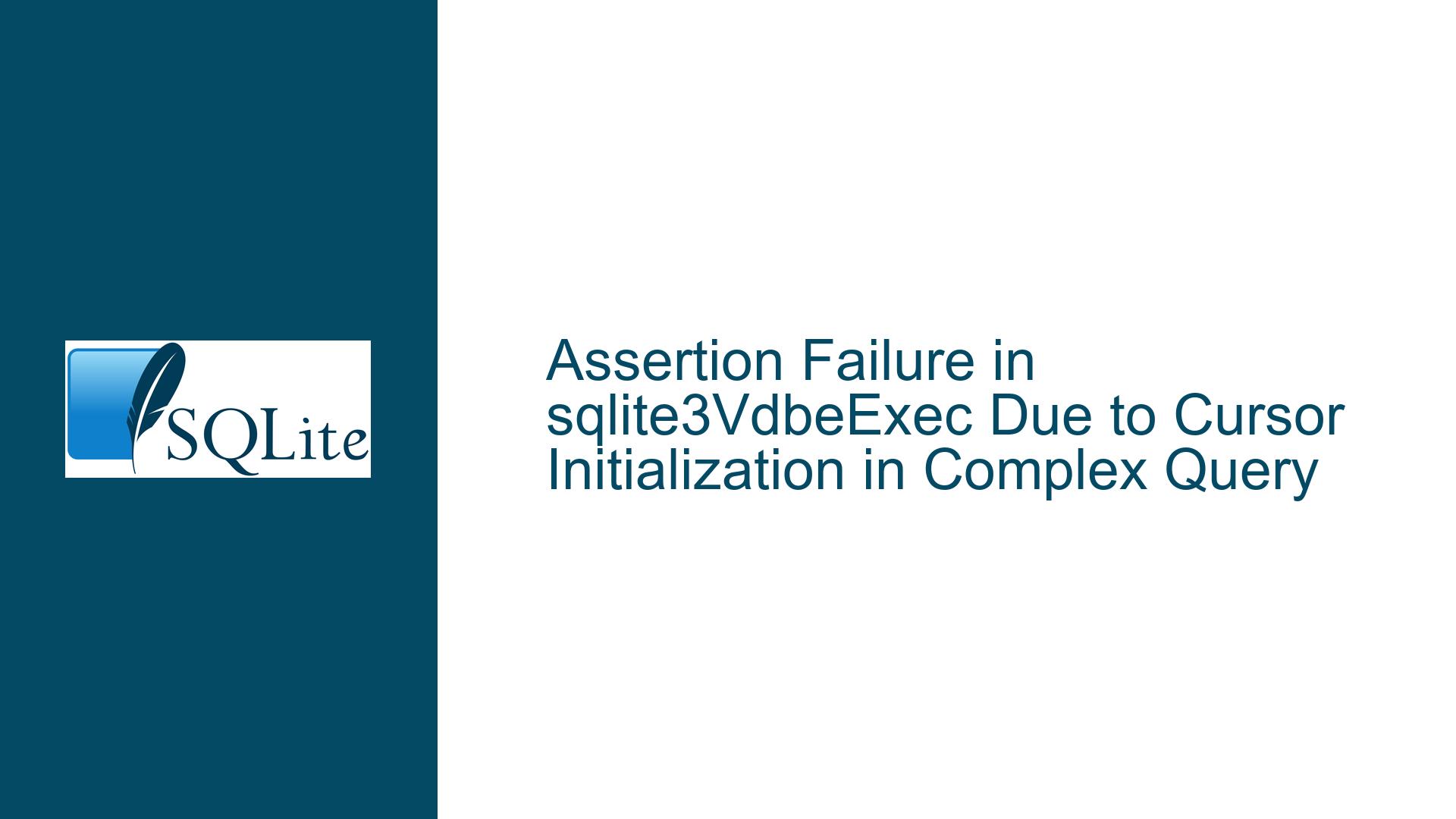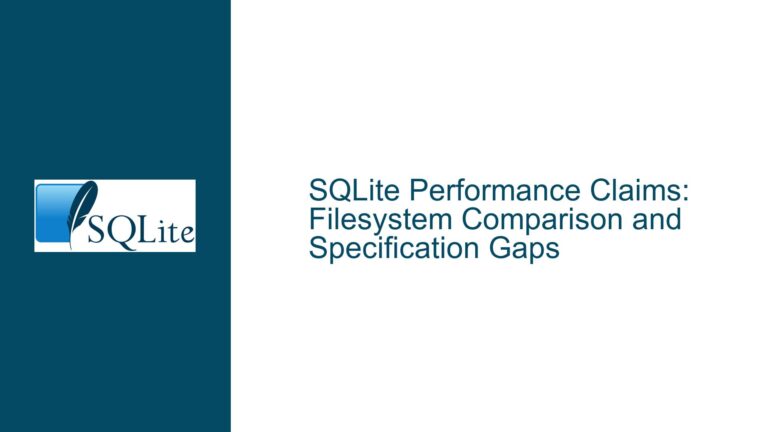Assertion Failure in sqlite3VdbeExec Due to Cursor Initialization in Complex Query
Understanding the Core Failure: Cursor Initialization in Window Function Contexts
The assertion failure pC!=0 in sqlite3VdbeExec arises when SQLite attempts to access a database cursor (VdbeCursor) that has not been properly initialized or has been prematurely closed during query execution. This occurs specifically in queries involving window functions, aggregation with GROUP BY, and collation-sensitive views when certain query optimizations are enabled. The failure is triggered by a mismatch between the query planner’s assumptions about cursor availability and the actual state of cursor lifecycle management during the execution of window functions in HAVING clauses.
The error manifests in the following scenario:
- A table (
v0) with aUNIQUEcolumn (c1) and a second column (c) is created. - An
INSERToperation populates only columnc, leavingc1asNULL. - A view (
v1) is defined to selectc1withCOLLATE NOCASE, which implicitly castsNULLvalues into a collation context. - A
SELECTquery performs aLEFT JOINbetweenv0andv1, groups the results usingGROUP BY 1, and applies aHAVINGclause containing a subquery withsubstr()andlag()window functions.
The assertion failure occurs because the cursor (pC) associated with the window function’s partition or the underlying view’s collation processing is not initialized when the lag() function attempts to reference it. This is exacerbated by query optimizations (e.g., SQLITE_CoverIdxScan) that alter cursor lifecycle management.
Root Causes: Query Optimization, Collation, and Window Function Interactions
1. Incorrect Cursor Lifecycle Assumptions in Optimization Flags
The SQLITE_CoverIdxScan optimization (enabled by default) allows SQLite to use covering indices to avoid table lookups. However, when this optimization interacts with queries involving window functions and collation rules, it may prematurely close cursors or skip their initialization. The lag() window function in the HAVING clause’s subquery requires a cursor to traverse partitioned data, but if the optimizer assumes the cursor is unnecessary (due to covering index logic), pC remains uninitialized, triggering the assertion.
2. Collation Rules and Implicit NULL Handling in Views
The view v1 applies COLLATE NOCASE to c1, which modifies how NULL values are handled during comparisons. Since the INSERT into v0 leaves c1 as NULL, the collation rule forces SQLite to treat NULL as a valid value in the view’s output. This collation context propagates to the LEFT JOIN and GROUP BY operations, creating a dependency on cursor states that are not properly managed when the query includes window functions.
3. Window Function Execution During HAVING Clause Evaluation
The HAVING clause is evaluated after GROUP BY, meaning the subquery containing lag() must process aggregated data. Window functions like lag() rely on cursors to iterate over partitions, but if the query planner fails to allocate a cursor for the partition (due to PARTITION BY 0, which groups all rows into a single partition), the cursor (pC) is not created, leading to the assertion failure. The PARTITION BY 0 clause is particularly problematic because it creates a degenerate partition that may bypass cursor initialization logic.
Resolution: Debugging, Workarounds, and Code Fixes
Step 1: Diagnose Query Execution with EXPLAIN and Optimization Control
Begin by analyzing the query execution plan using EXPLAIN and EXPLAIN QUERY PLAN. Compare the output with and without the SQLITE_CoverIdxScan optimization:
.testctrl optimizations 0x00000020 -- Disable CoverIdxScan
EXPLAIN QUERY PLAN
SELECT 0 FROM v0 LEFT JOIN v1 AS a0 GROUP BY 1 HAVING ...;
Observe whether disabling the optimization changes the use of cursors for the window function or the view’s collation processing. If the query succeeds with the optimization disabled, this confirms that cursor management under CoverIdxScan is flawed.
Step 2: Modify the Query to Isolate the Issue
Temporarily simplify the query to identify the exact component causing the failure:
- Remove the
COLLATE NOCASEfrom the view definition. If the assertion no longer occurs, the collation rule is contributing to cursor mismanagement. - Replace the
lag(0)window function with a constant. If the error disappears, the window function’s cursor requirements are the culprit. - Populate
c1with non-NULL values inv0. If the query succeeds, the interaction betweenNULLhandling and cursor initialization is faulty.
Step 3: Patch the Cursor Initialization Logic
The root cause lies in the sqlite3VdbeExec function’s handling of cursors for window functions in degenerate partitions. Modify the code to ensure cursors are initialized even for PARTITION BY 0 clauses:
- In
sqlite3WindowCodeStep(), add a check for empty or constant partition expressions. Force the allocation of a cursor for these cases. - In the optimization logic for
CoverIdxScan, add a condition to skip the optimization if the query contains window functions with degenerate partitions.
Step 4: Apply Compilation Flags for Debugging
Recompile SQLite with debugging flags to trace cursor activity:
export CFLAGS="-g -O0 -DSQLITE_DEBUG -DSQLITE_ENABLE_TREETRACE -DSQLITE_ENABLE_WHERETRACE"
./configure
make
Run the query with tracing enabled:
.tree
.trace
SELECT 0 FROM v0 LEFT JOIN v1 AS a0 GROUP BY 1 HAVING ...;
Inspect the logs for cursor initialization steps and identify where pC is not assigned.
Step 5: Implement Runtime Workarounds
If patching SQLite is not feasible, use these runtime workarounds:
- Disable
SQLITE_CoverIdxScanwith.testctrl optimizations 0x00000020before executing the query. - Rewrite the query to avoid
PARTITION BY 0andlag(0). For example, usePARTITION BY c1and handle NULLs explicitly. - Materialize the view
v1into a temporary table to bypass collation-related cursor issues:
CREATE TEMP TABLE temp_v1 AS SELECT c1 COLLATE NOCASE FROM v0;
SELECT 0 FROM v0 LEFT JOIN temp_v1 AS a0 ...;
Step 6: Validate with Regression Tests
After applying code fixes, run regression tests to ensure the assertion failure does not recur. Include test cases for:
- Queries with
PARTITION BYconstant values. - Views using
COLLATEclauses on columns withNULLvalues. HAVINGclauses containing subqueries with window functions.
By systematically addressing cursor lifecycle management in window function execution and collation processing, this assertion failure can be resolved.






